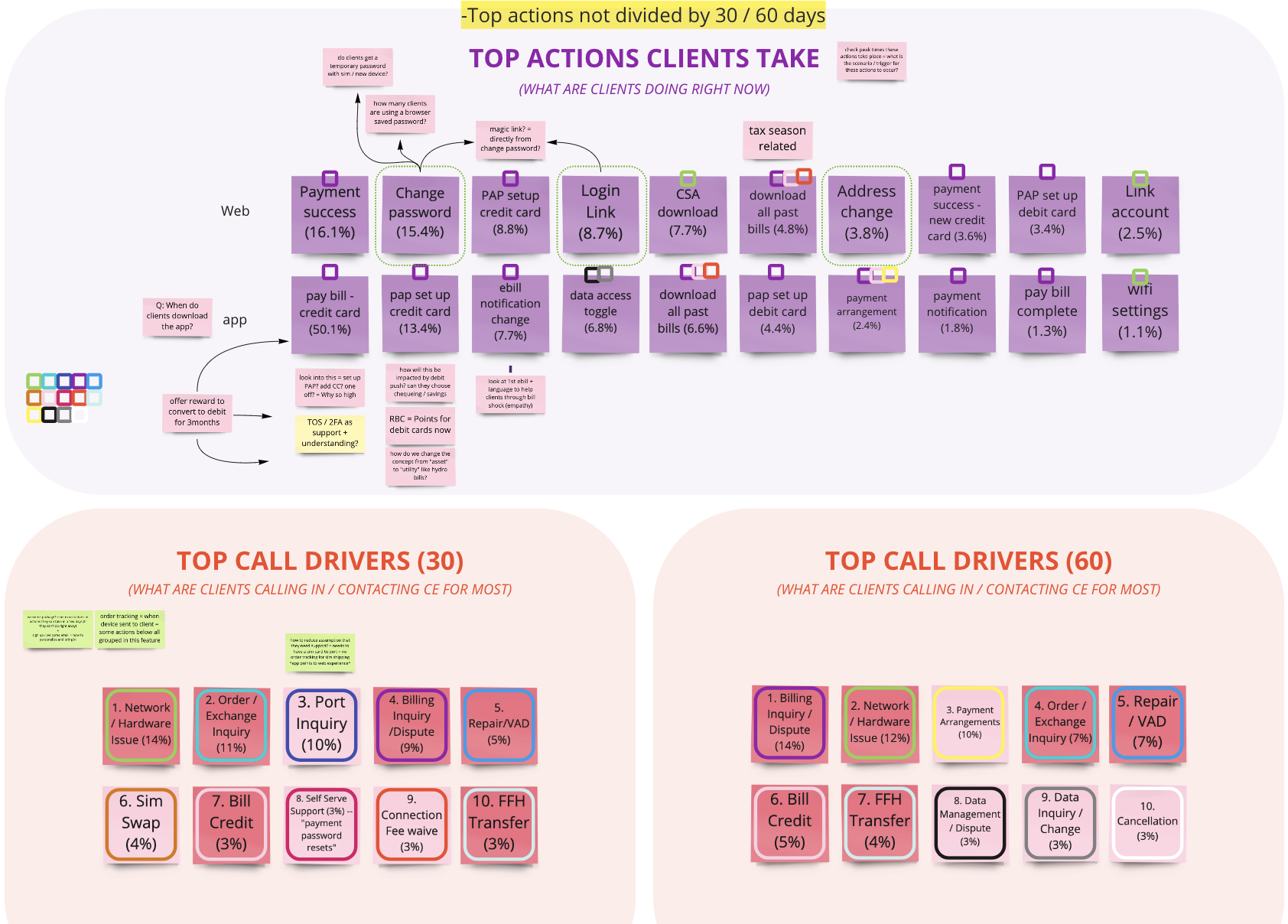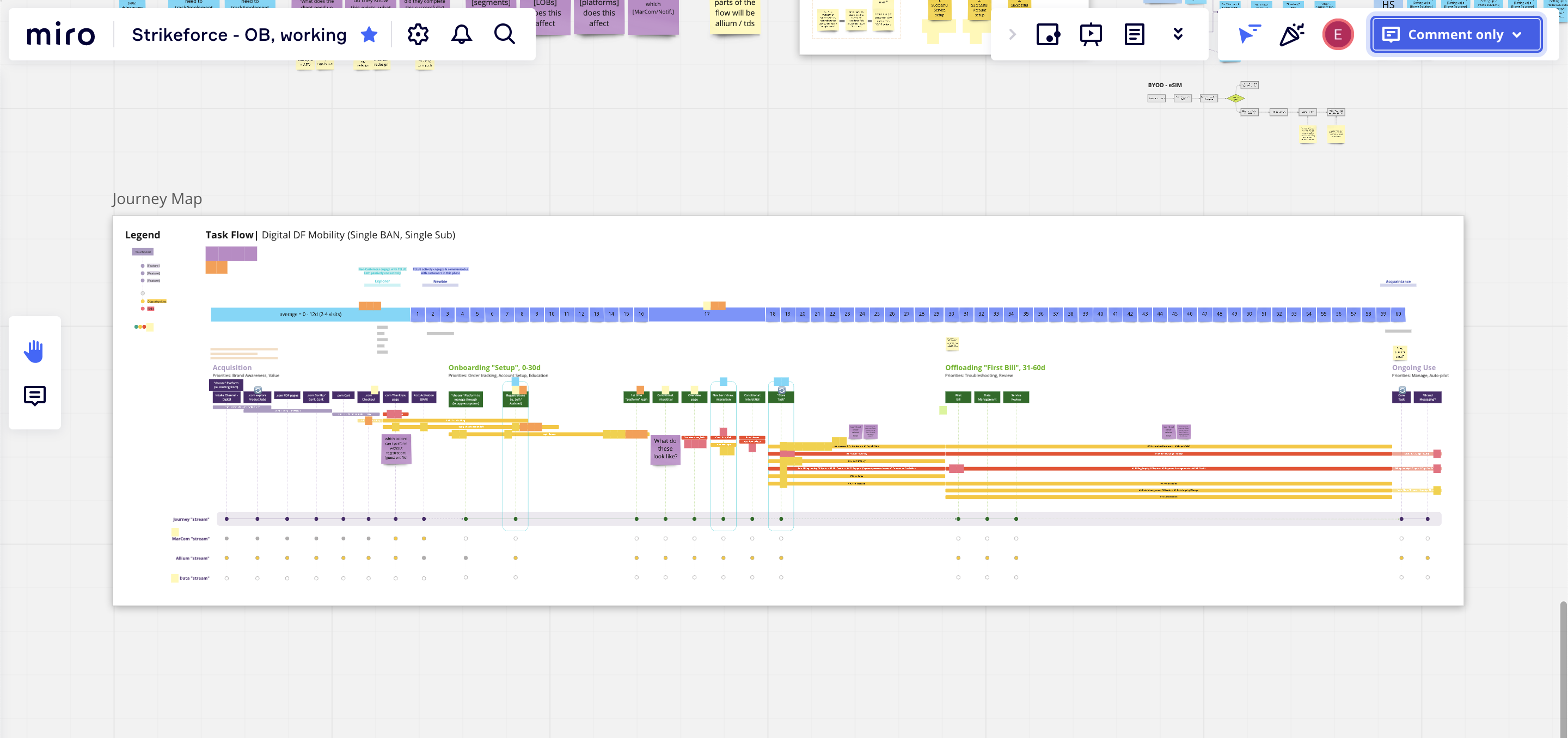
Driving User-Centric Transformation for Operational Efficiency
I led the experience strategy for TELUS to transform customer onboarding, reducing call drivers within the first 60 days. By implementing a user-centered and data-driven approach, the program achieved over $600K in operational savings and a 20% reduction in customer support calls within the first 3 months.
Role: Product Design Lead
Timeline: Phased over 1 year
Responsibilities: Program Positioning, End-to-End Experience Strategy, Design Leadership

Aligning Goals Through Strategic Reframing
Initially scoped as a simple post-login banner, I leveraged my expertise to identify a broader, omnichannel approach within the onboarding journey.
I facilitated workshops with product, engineering, business, and voice-of-customer (VOC) leads to align on user-centric goals. Using reframing techniques and tools like the Lean UX Canvas, I guided exploratory discussions that revealed a single banner would not achieve the desired impact. Synthesizing insights from these sessions, my team identified key themes such as user comprehension and trust, laying the foundation for a more impactful strategy.

Diagnosing Pain Points Through Data Audits
After aligning goals, I collaborated with cross-functional teams—including product, marketing, analytics, and customer operations—to audit current onboarding data. Our objective: understand call drivers and uncover opportunities to encourage self-service behaviours.
Pinpointing Opportunities
Through data analysis, we discovered gaps between business KPIs and user behavior. For example, while stakeholders assumed users logged in within 7 days post-purchase, data revealed first logins occurred around 30 days, coinciding with billing cycles. By categorizing call drivers and mapping behaviours, I lead workshops with product and business to build hypotheses about pain points and identify solution opportunities.


Visualizing the Customer Journey
I developed a two-year client lifecycle map — since most service plans lasted 2 years — and expanded it into a current-state service blueprint for client onboarding. Using behavioural archetypes, I highlighted key mindset shifts and visualized client pain points with colour-coded markers. Presenting these findings to stakeholders uncovered enterprise-level gaps within our experiences and clarified the scope needed to transition from the current state to the ideal state.



Elevating Onboarding from Feature to Program
Discovery data showed the need for a comprehensive, end-to-end onboarding journey to meet self-serve and retention goals. To secure buy-in from stakeholders, I used data-driven storytelling with an analogy of Ikea’s furniture assembly process. This story illustrated the frustration customers faced without adequate guidance.
I highlighted a critical insight: the first 20% of a customer’s journey accounted for 80% of their self-serve success. Rooting stakeholder discussions in these findings, I gained alignment on the necessity of a phased, programmatic approach.

Delivering Value Through Phased Execution
Given the scope, we adopted a phased delivery approach using the Now, Next, Later prioritization methodology. I successfully pitched the formation of a dedicated program workstream team comprising design (me), product, business, and technology leads. Together, we governed execution and ensured clear communication of delivery timelines.
Targeting Pain Points
I conducted an experience analysis which revealed billing, usage, and account setup as primary drivers of onboarding issues:
- Billing Pain Points (54% of calls): Issues like bill shock and missing credits were addressed through the e-Bill redesign project.
- Account Setup Issues (46% of calls): Lack of UI familiarity and suboptimal navigation were prioritized, with my program team taking ownership of account setup flows.

Maintaining Consistency Across Teams
As we worked to deliver our product roadmaps, many teams were involved to support execution, so consistency was critical.
Establishing Experience Pillars
To ensure consistency across solutions, I co-developed experience pillars that served as design guidelines for all teams. These pillars informed the phased delivery of tactics, balancing functional, delightful, and experiential enhancements.

Coordinating Cross-Functional Efforts
I led workshops to align solution tactics across workstreams, enabling product owners to communicate their roadmaps and avoid duplication. These sessions fostered cross-functional transparency and streamlined execution. We took note of solution tactics that were in flight, shipped, backlogged and to be updated in future phases.


Strategic Tactics for Impactful Delivery
The final onboarding program encompassed over 10 omni-channel tactics, each phased for delivery and supported by dedicated workstream teams. High-priority tactics included:
- Onboarding emails
- Account Activation & Registration
- Account Overview Redesign (Consumer and Business)
- Pending & Active account states
- Top Actions Area
- Navigation Redesign
- Network & Hardware Device Setup
- Wireless Network & Phone Number Porting
- Order Exchange & Device Tracking
- Digital Bill Statement Redesign
